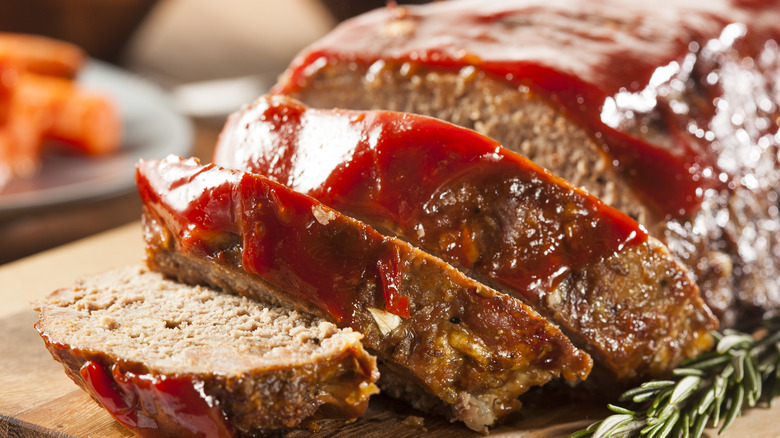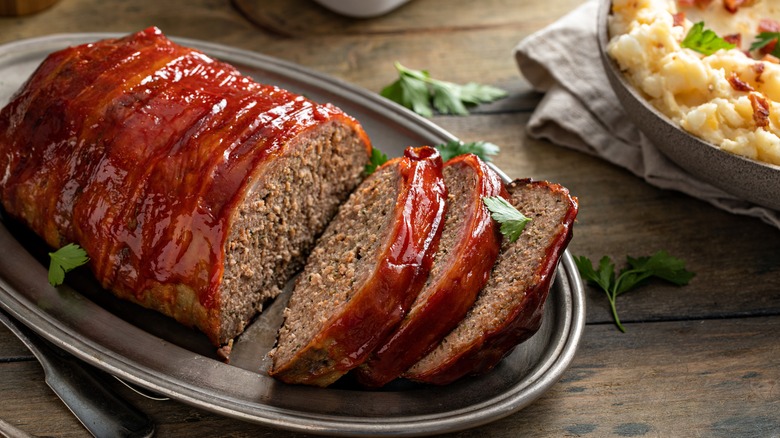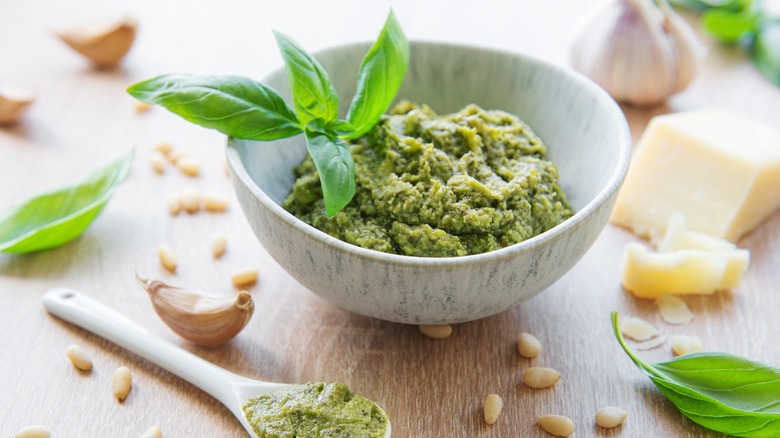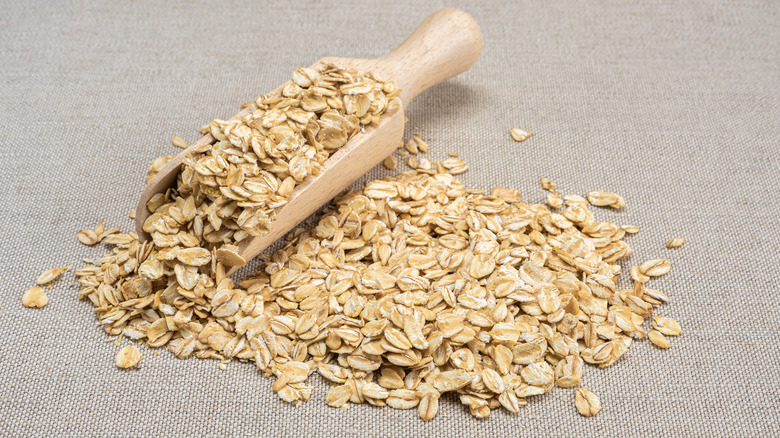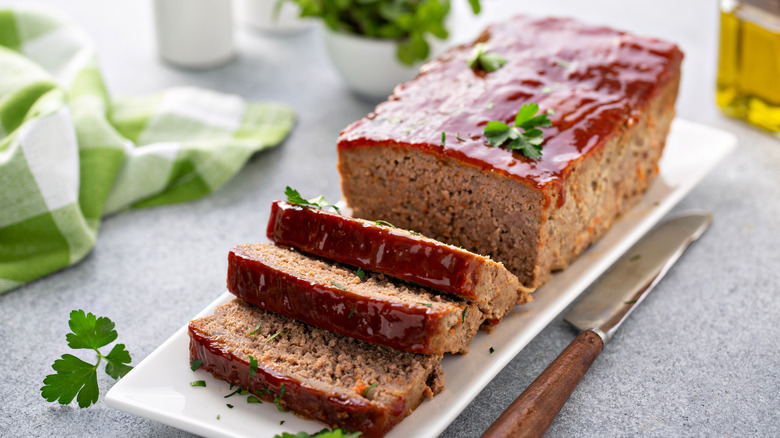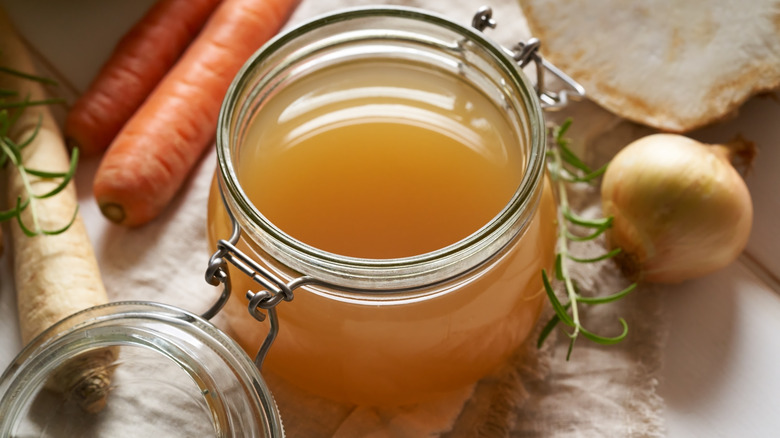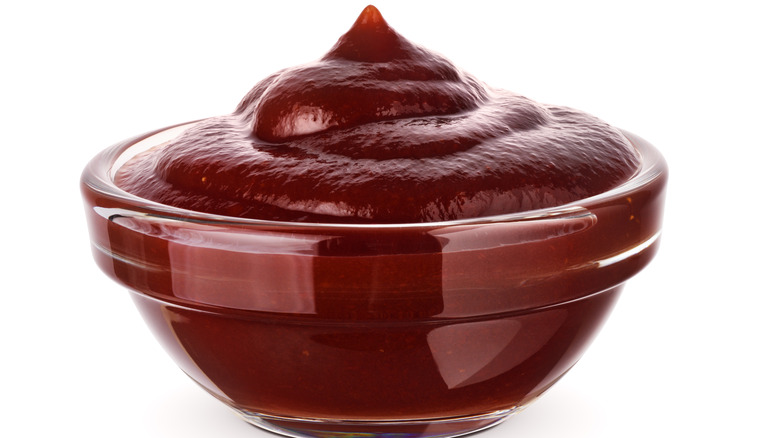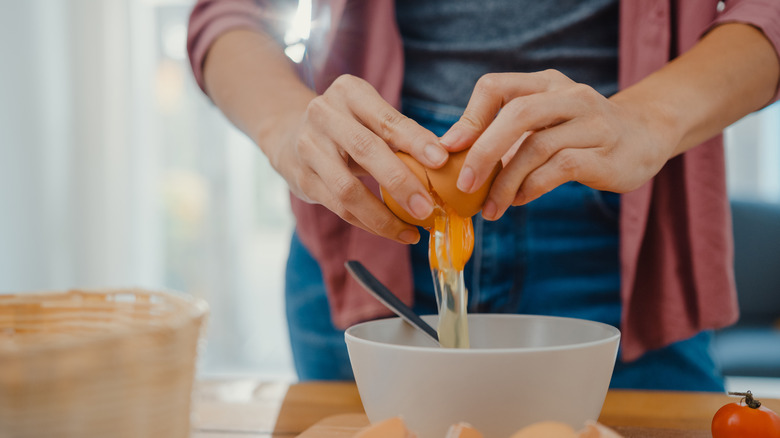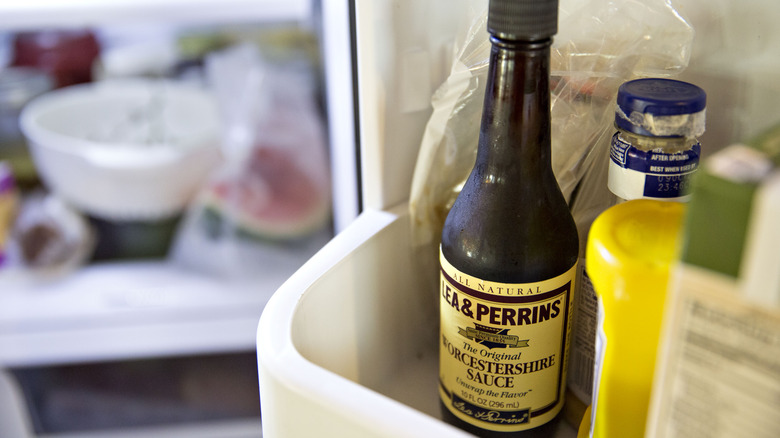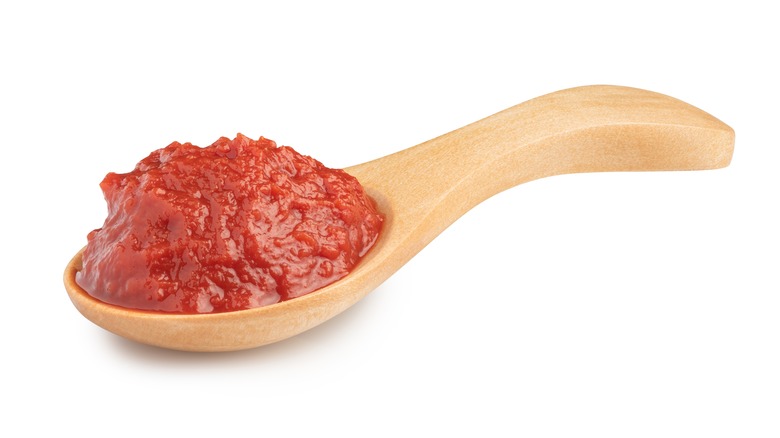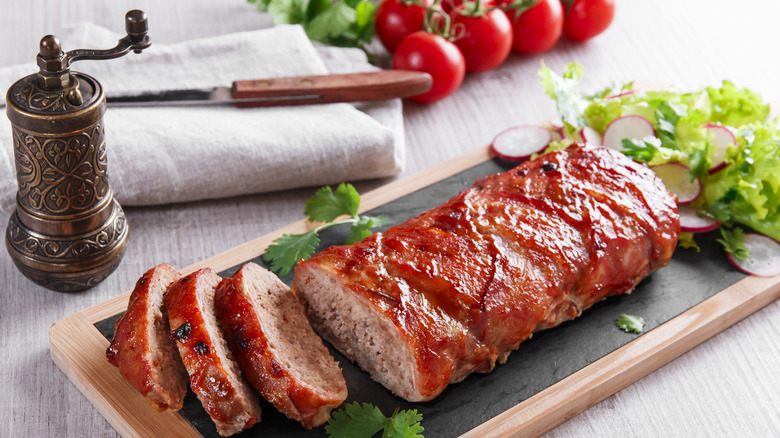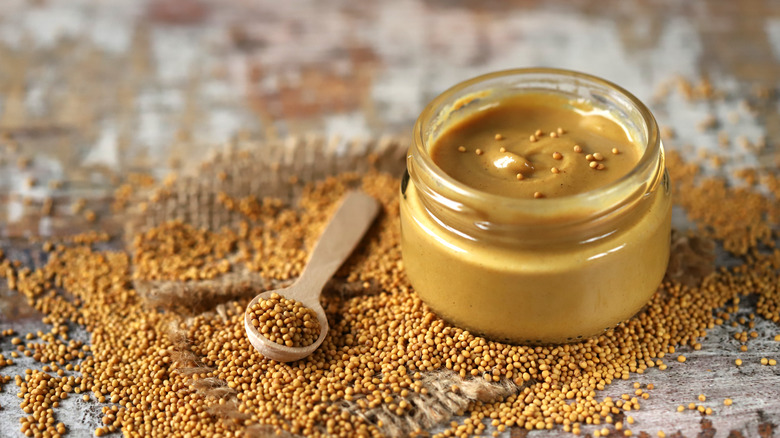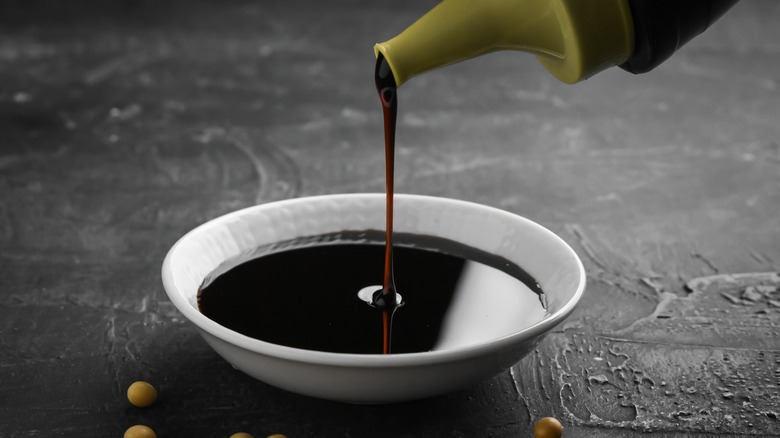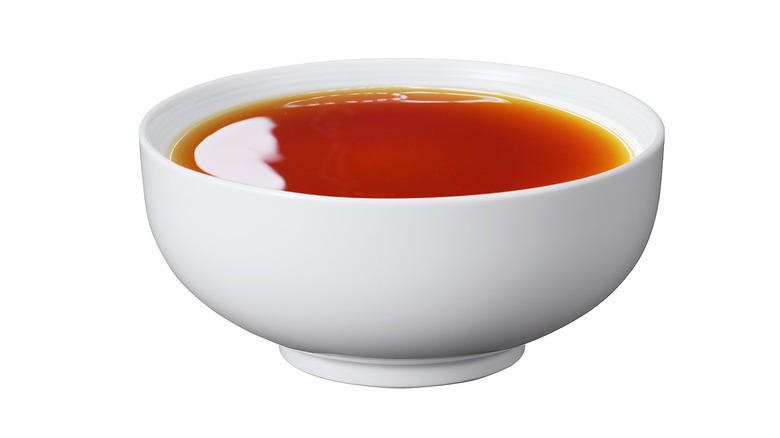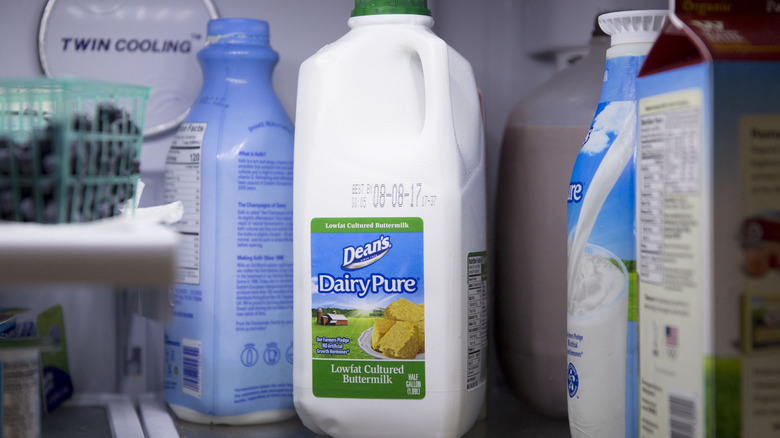16 Ingredients That Will Help Keep Meatloaf Moist
When you think of the phrase "home-cooked meal," does meatloaf come to mind? Meatloaf is a nostalgic, savory blend of ground meat, herbs, and flavoring baked inside a rectangular pan. According to The Atlantic, meatloaf recipes have spanned the globe, including the pastez, a Medieval Europe disc-like concoction made with leftover cuts of meat, fruits, nuts, and seasonings, and the Pennsylvania Dutch's scrapple, a proto-meatloaf made with pork trimmings, cornmeal, and seasonings left to congeal before being sliced and pan-fried. The Atlantic notes that the first version of "American" meatloaf (think ketchup glaze and made with a mix of pork, veal, and beef) was printed in recipe books in 1899. The dish has since persevered because it can be made with the scraps of other more valuable cuts of meat and can be flavored with a variety of vegetables, herbs, and regional seasoning.
We should note that the hallmark of a great meatloaf is not only its flavors but also its moistness. Dry meatloaf crumbles when you try to cut it — and if you get to eat it, you'll find the texture tough and like eating a freezer-burned, flavorless burger. But fear not — there are some simple ingredients you can use to improve the texture of your meatloaf and pack in moisture.
Water
If your meatloaf is too dry, you might think the logical solution may just be to add more water. And you'd be correct.
Water may not add more flavor to your meatloaf, but it does add a bit more moisture to your meatloaf. You should plan to add water to your meatloaf at two separate times: with your ground meat as well as after you use water to deglaze your vegetable-cooking saucepan. Then, the question arises of exactly how much water you should add to your meatloaf. You can start by adding one tablespoon of water to the meat mixture at a time, but you'll want to stop adding water when the meat starts to pull away from the sides of the bowl. If your recipe uses more liquid seasoning rather than dried seasoning and herbs, you won't need to add as much water. Incrementally adding water and observing the texture of your meatloaf as it comes together is bound to result in a moist, plush meatloaf.
Ketchup
You may think of ketchup solely as the iconic topping for American meatloaf, but this condiment can do a lot to bolster moisture in meatloaf as well. Many recipes call for adding ketchup to both the top of the meatloaf as well as directly into the meat mixture. The texture of the ketchup is thick, so it does not easily evaporate in the oven, and its taste is mildly sweet, which balances the savory notes in the meatloaf. The inclusion of tomato paste in the ketchup also brings out an elusive umami flavor.
Adding a ketchup glaze to the top of the meatloaf seals in the moisture in the meatloaf underneath and caramelizes slightly when the loaf is baking. For a more unique ketchup flavor, we also recommend serving your meatloaf with a side of homemade spicy ketchup — it's made with cumin, coriander, turmeric, malt vinegar, and brown sugar.
Pesto
Since meatloaf is often seasoned with Italian herbs, it wouldn't be uncommon to see basil added to meatloaf for flavor. But what about adding basil in the form of pesto?
Pesto is a great addition to meatloaf because it adds moisture without making the meatloaf too wet. The combination of olive oil, parmesan cheese, fresh basil, and pine nuts adds a fattiness to the meatloaf that seals in the moisture and can complement any blend of meats you incorporate into your recipe. You should mix the pesto into the meat mixture as well as blend some of the sauce with ketchup to add to the top of the meatloaf. This will make sure your meatloaf stays super moist and herb-forward.
Pesto meatloaf pairs well with numerous side dishes like mashed potatoes and roasted veggies. And who knows? Maybe you'll try to start to use pesto as more of an ingredient than just a pasta sauce.
Oatmeal
Your go-to starch for meatloaf may be breadcrumbs, but after you try adding oatmeal to your meatloaf you may reconsider all of your future meatloaf recipes. Not only do oats have the same (if not better) binding potential as breadcrumbs, but making this simple swap can also make your meatloaf gluten-free. You won't notice a rubbery texture when you use oatmeal instead of breadcrumbs, but you will notice that your oatmeal does not dry out as quickly as plain breadcrumbs. Moreover, oatmeal includes beta-glucan, a heart-healthy fiber that promotes feelings of satiety and may aid in blood sugar management (via Healthline).
You should add oatmeal directly to your meat and vegetable mixture. Quick-cook oats are a better fit for oatmeal because meatloaf doesn't take very long to bake. If you use whole rolled oats, you may find that the texture of the oatmeal is a bit more obvious.
Pork
Fat is the key component to keeping your meatloaf moist — and a lot of that fat will come from the meat you choose to use for your meatloaf. People use many different types of ground meat in meatloaf, including beef, veal, and turkey, but our favorite blend of meat for a meatloaf includes fatty pork. While many types of "meatloaf blend" meats sold at the grocery store contain some proportion of veal, beef, and pork, there is rarely enough fatty meat to promote moisture retention in the meatloaf. This is why you may need to add extra ground pork round as a fatty supplement to your meatloaf.
The ideal amount of pork in your recipe is about ¼ to ⅓ of the total meat mixture. If you can't find ground pork at your grocery store, you can grind your own at home using a pork shoulder or loin and your handy household food processor.
Stock or broth
If adding water was one of the ways you could alleviate a dry meatloaf, think of adding stock or broth as a more flavorful, hydrating ingredient to include in your meatloaf. Stock is made by simmering animal bones with vegetables, herbs, and seasonings together in the water. Not only will you get the flavor of the meat immersed in the liquid, but you will also find that stock extracts some of the collagen from the cartilage in the meat which instills more flavor. The broth is less flavorful and is made by poaching the meat quickly with seasonings rather than allowing for a few hours of extraction time.
We recommend adding a tablespoon of stock or broth at a time to your meat mixture to help boost the moisture. Like the water, you'll want to wait until the meat starts to pull off the side of the bowl and come together in a cohesive bowl. Beef stock is one of the most flavorful types of liquid you can add to your meatloaf; you'll get a ton of savory notes that complements the ground beef that makes up the base of the meatloaf.
Barbecue sauce
Barbecue sauce is a key ingredient in a southern meatloaf recipe. Slathering a layer of barbecue sauce on the top of the loaf, as a replacement for ketchup, locks the flavor in and adds a smokey, mesquite undercurrent. The vicious nature of this popular condiment is the perfect flavoring and moisture-inducing ingredient. You can add a bit of barbecue sauce to your meat mixture to keep the loaf moist, as well as impart a bit of sweetness that complements whatever meat blend you use.
There are many different brands you can choose from when it comes to barbecue sauce. Or, if you're an overachiever (or passionate flavor-seeker — we won't judge), you can make a spicy bourbon-chile barbecue sauce to add to your meatloaf. You'll get a bit of heat from Thai chilis complemented with the sweetness of dark brown sugar and honey. If you're working with a medley of ingredients and vegetables in your meatloaf, you may want to be a bit cautious not to add too much barbecue sauce to obscure the organic texture of the onions, celery, and carrots.
Red wine
Red wine and red meat go hand-in-hand, so it isn't surprising to know that it's one of the best things you can add to boost the flavor and moisture in your meatloaf. Drink and Pair notes that the wines that work best with the flavors of meatloaf are cabernet sauvignon and merlot; the flavors are oaky and warm, and complement both the meat and the vegetables in the meatloaf. You can add your choice of red wine either directly to the meat and vegetable mixture or infuse it into the breadcrumbs.
When you're cooking with wine, you should always use a wine that you're willing to drink. Since cooking breaks down some of the flavors in the wine, you shouldn't expect your meatloaf to taste the same as a bottle you'd buy from a liquor store. However, you might find the pungent bitter, acidic, or sweet notes from the wine shine through. If you don't like these flavors in your wine, you probably won't like them in your meatloaf either. And although you might want to find a wine you can sip out of the bottle in between pouring it into your meat mixture, you should also be wary of choosing a wine that doesn't break the bank.
Eggs
Bakers know the importance of eggs when it comes to moist cakes, cookies, or sweet bread — meatloaf is no different. Eggs provide two vital functions when it comes to meatloaf. The egg yolks are fatty, thus aiding in binding the meat together without having to overwork it. The fat in the yolks also doesn't evaporate like water, so it will retain the moisture in your meatloaf as it bakes.
If you're out of eggs or have an egg allergy, you can use other ingredients to mimic the same binding effect. Olive oil can help the meat stick to your vegetables, while mayonnaise offers a hybrid experience between adding eggs or oil. Two tablespoons of mayonnaise for each egg in the recipe should do the trick. Olive oil, or other neutral types of oil, do not have the same 1-to-1 ratio because the oil is much runnier and may cause your meatloaf to be too moist, so plan on adding less.
Worcestershire sauce
Ah, Worcestershire sauce — even if you can't pronounce it, you can still use it in meatloaf. This umami-rich sauce has many of the same flavors as a thick fish sauce or soy sauce. Worcestershire sauce is made with a few seemingly simple ingredients including molasses, tamarind paste, onion, garlic, spices, vinegar, and one slightly more unconventional ingredient — fermented anchovies. This makes this thick sauce more pungent than other meatloaf flavorings, but it also makes it unsuitable for folks with seafood allergies. If you need a fish-free replacement for Worcestershire sauce, you can make a substitute by combining equal parts of tamarind paste and balsamic vinegar. You'll get the sweet, acidic notes from the vinegar with the bulk and viscosity of the tamarind paste.
Worcestershire sauce is both a flavoring agent and a moisture-rich ingredient added to meatloaf. Our classic meatloaf recipe uses three tablespoons of Worcestershire sauce per two pounds of beef.
Tomato paste
Tomato paste is full of umami; it's perfect for adding a tomato undertone without the sweetness of ketchup. You can add a couple of tablespoons of tomato paste directly to your meat for moisture that won't evaporate as your meatloaf bakes. Just be sure to mix the paste in thoroughly; its viscous texture causes it to stick together in a ball unless otherwise dispersed.
The biggest problem with using tomato paste for a recipe like meatloaf is that you don't use enough of the paste to justify opening an entire can. But, there are a ton of ways you can use leftover tomato paste in the kitchen. You can freeze small rounds of the paste in plastic wrap and place them in your freezer for when you need a boost for a marinade or a homemade marinara sauce. You can also add tomato paste to your rice or grains like quinoa for an umami boost.
Bacon
Bacon is the fatty, savory, and delicious pork product that your meatloaf has been craving. You can opt for applewood-smoked bacon for more oaky notes, or stick to standard bacon for its classic diner flavor. Bacon can either be in your meatloaf cubed into small chunks or wrapped around the exterior of the loaf to seal in moisture. If you want to add the bacon to your meat mixture, you'll need to cook it first (not so it's too crispy — just cooked) and chop it into tiny pieces.
If you plan to wrap your meatloaf in bacon, you'll need to take a few extra steps. Line raw bacon strips throughout the inside of the pan and coat them with glaze; this will aid in the caramelization process and make your bacon much more flavorful. Then, add your meat mixture to the loaf pan and fold over your glazed-bacon strips so the loaf is covered. Bake your meatloaf in the oven and regularly add glaze to the bacon as needed.
Mustard
Since you already used ketchup to perfect your meatloaf recipe, it may not seem too far off to add another popular condiment: mustard! Mustard is a combination of mustard seeds — which can be brown, yellow, black, or white — vinegar, and other thickening agents. The resulting mustard is thick and very resistant to evaporation, making it the perfect flavorful ingredient to add to boost moisture in your meatloaf.
Our favorite type of mustard to add to meatloaf for both flavor and moisture is Dijon. This spicy mustard is made of a mix of brown and black mustard seeds with an acidic kick from verjuice. You can purchase Dijon in both textured and smooth varieties, we recommend going with the smooth to avoid disrupting the other flavors of the meatloaf. If you want to be a little less adventurous (for which we won't blame you), you can use a few tablespoons of American yellow mustard to flavor your ground meat.
Soy sauce
Soy sauce is a condiment used for Asian-inspired stir-fries, rice dishes, and meat marinades, but this versatile sauce can make a world of difference in flavoring and adding moisture — especially if you have already salty ingredients mixed in.
Soy sauce is a perfect match for an Asian-inspired meatloaf. You'll need to add about two tablespoons of soy sauce for each pound of ground turkey in this recipe, which is a little more than you may add to a beef or pork meatloaf. Ground turkey is especially bland when it's cooked, so you'll need to add a lot of soy sauce to make up for the lack of other flavors in the meat. This recipe also adds a hint of fat with sesame oil, which can also help add moisture to your meatloaf. Just be sure to add a little less if you're using a traditional ground beef-based meatloaf mixture.
Fish sauce
Although it is not suited for all diets, fish sauce has a lot of potential for adding moisture and umami-richness to your meatloaf. This ingredient is common in many Asian dishes but is a tasty complement to tomato and ground meat. Fish sauce is made by fermenting fish (typically anchovies) for months — or up to several years. The result is a brown liquid packed with glutamates: the cornerstone of the umami flavor. You can mix a few tablespoons into your meat mixture as you are preparing it.
Since the fish sauce is made with — you guessed it — fish, it is not a suitable ingredient for individuals with seafood allergies. If you want to avoid using fish sauce in your meatloaf, you can purchase a vegan alternative. One umami-rich ingredient that replicates some of the glutamates in fish sauce is coconut aminos. Coconut aminos are made with fermented coconut sap and sea salt, giving them the same texture as both soy sauce and fish sauce, but with a sweeter undertone.
Buttermilk
You have to get creative with meatloaf, so we're putting our adventurous hats on and recommending that you try adding a splash of buttermilk to your next homemade meatloaf. Buttermilk is a byproduct of the butter-making process and has a tang similar to that of yogurt. It's also thicker than milk, which can aid in binding your meat and breadcrumbs together. You're bound to be pleasantly surprised by the tenderness that the buttermilk imposes on the meatloaf recipe, even with just a few tablespoons.
If you have leftover buttermilk, you can use a splash to help marinate chicken; the acidity of the dairy product helps break down the proteins in the meat resulting in a succulent fried chicken. You can also stick to the sweet applications of buttermilk, like making a delicious buttermilk biscuit recipe or upgrading your special morning flapjacks. You can also freeze buttermilk to use at a later time, which is a good idea if you make meatloaf frequently.
